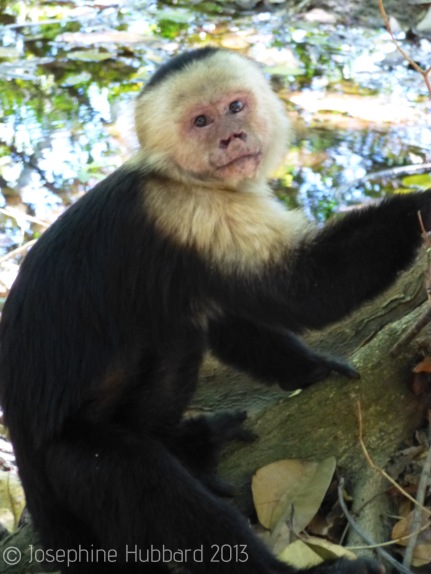
It was nearly daybreak. In the twilight of the dry-forests of Costa Rica, I sat silent at the base of a giant tree along the trail. As everything around me slowly came into focus, the trees started to stir. At the top of the tree under which I sat, monkeys began to wake up and move amongst the branches. At first they just appeared as dark silhouettes, but within a few minutes I would begin to recognize the faces of the individuals in a group I had come to know and love, Rambo’s group.
The new leader Moth now called the shots in this group, and his favorite male scapegoat was Bentley. Moth was protective over his groups’ interactions with peripheral males (like Bentley) and would commonly enforce this through aggressive chasing or dominance displays.

Bentley was an older male with a raggedy, old man look about him. He was large, but his confidence level did not reflect this fact. He would skirt around the edge of Rambo’s group, hoping to catch the eye of a female, or a sub-adult male compadre. Occasionally he’d have his 10 minutes of fame getting groomed by some pubescent male that had no other social partners his own age; however, these fleeting moments were often ended by a swift chase from Moth to push Bentley back to the edge of the group’s territory.
This put us in a tough spot as research assistants. We were helping on a project looking at female mate choice in these wild groups of white-faced capuchins. In order to assess who these females were choosing to mate with, we needed to collect data on both female and male adults throughout the mating season. Bentley was one of our “focal subjects” that we were required to follow. The problem was, he was rarely there.
On this particular morning, however, I spotted Bentley early. The group had left their sleeping tree, crossed the creek and darted up the embankment. Struggling to keep up, and keen on keeping my eyes on Bentley, I called to my colleagues to indicate that I had found a focal to follow. I was eager to get these observations out of the way. It had been days since the last time we had seen him, and who knows when he would take off again.
I continued to follow Bentley, who jaunted up and over the crest of the hill, where I assumed the rest of the group was headed. My colleagues came rushing up, and were delighted when they saw who I had found. It had seemed like the perfect start to the day. Our focal observation protocol allowed us to follow subjects in any order, as long as observations were balanced. This meant that if we collected one focal observation on all individuals but one, we needed to find that last individual and observe them before we could start again at the top of the focal list. Beginning with Bentley meant we could move on to observing anyone else in the group and not care if he disappeared shortly thereafter. By the end of the observation period, we were all exchanging high-fives and big smiles, and soon began to look around for our next focal.
But there was no one to be found. We all froze, and listened for a few seconds, but all we could hear was the whistling of the wind through the trees. There was not one monkey around. The rest of the group had left while we were all so intently focused on watching Bentley’s sad existence of foraging alone.
A morning that had started so well, had now in just 15 minutes, turned so sour. Now we had to split up and search the forest. We all went in different directions and kept our walkie-talkie’s close. We walked up and down the hills of the trail system for hours and couldn’t find a soul. At noon we re-grouped and strategized about where they might be. After some contemplation, we decided to check the river, since they like to nap there on particularly hot days.

And there they were, taking a relaxing siesta. As we walked up, a juvenile rolled over on the branch and looked up at me with his sleepy eyes almost as if to say “where’ve you guys been?”. From that day forward, I’ve always been weary of watching the loners. You never know where they might take you.
Author: Josie Hubbard is a 1st year PhD student in Animal Behavior. She studies non-human primate social behavior. This field fiasco occurred during her gap year work in the Perry lab of UCLA at the Lomas field site (Reserva Biológica Lomas Barbudal) in Costa Rica.
More information on Dr. Perry’s work and the Wild Capuchin Foundation can be found here: capuchinfoundation.org